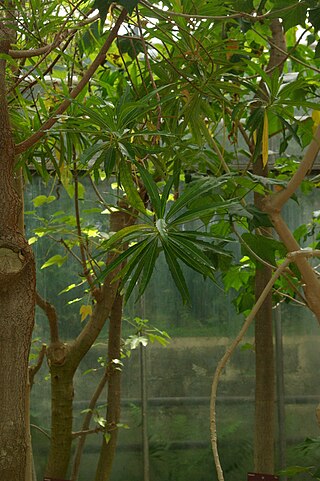
The Passifloraceae are a family of flowering plants, containing about 750 species classified in around 27 genera.

Turneraceae Kunth ex DC. is a family of flowering plants consisting of 120 species in 10 genera. The Cronquist system placed the Turneracids in the order Violales, but it is not currently recognized as a family by the Angiosperm Phylogeny Group in the APG III system of 2009, which includes the taxa in the Turneraceae in Passifloraceae as a subfamily (Turneroideae).

Adenoa is a monotypic genus of flowering plants belonging to Turneroideae (Passifloraceae).
Ambilobea is a genus of flowering plants belonging to the family Burseraceae. It is a dioecious tree or shrub, up about 20 m tall. Leaves are alternate, odd-pinnate. Inflorescences are axillary and flowers are inconspicuous.

Arboa is a genus of flowering plants belonging to the family Passifloraceae.

Piriqueta is a genus of flowering plants belonging to Turneroideae (Passifloraceae).

Erblichia is a monotypic genus of flowering plants belonging to the family Passifloraceae. The only species is Erblichia odorata, common name Butterfly tree or Flor de Mayo. Originally the genera was composed of five species, however, these species are currently classified as heterotypic synonyms. Unlike other members of Turneroideae which exhibit distyly, E. odorata is a homostylous species.

Hyalocalyx is a monotypic genus of flowering plants belonging to the family Passifloraceae. The only species is Hyalocalyx setifer.

Mathurina is a monotypic genus of flowering plants belonging to the family Passifloraceae. The only species is Mathurina penduliflora.

Oxossia is a genus of flowering plants in the subfamily Turneroideae (Passifloraceae) consisting of 15 species. This genus was recently defined in 2019 after a phylogenetic analysis of Turnera justified the creation of the genus. The genus is characterized by its stipules, small flowers, congested inflorescences, "hairy" stamen and style, and the attachment of stamen to the floral tube. All members of the genus are heterostylous with the exception of O. dasystyla. The genus can be divided into two morphological groups: those with white petals and those with yellow pink or red petals.

Arboa antsingyae is a tree found in western Madagascar. While A. antsingyae is currently classified as critically endangered, it is currently unknown if A. antsingyae is extant as the last observation of the species was in 1952. Previously it was classified as Erblichia antsingyae and Piriqueta antsingyae, however, phylogenetic analysis suggested reclassification of the species in Arboa.

Arboa berneriana is a shrub or tree that grows in the wet tropics of northern Madagascar. It has varying ranges of colors from yellow to orange to red.

Arboa integrifolia is a shrub or tree with yellow flowers that grows in the dry tropics of Madagascar. A. integrifolia was previously classified as Erblichia integrifolia, Paropsia integrifolia, Piriqueta integrifolia, and Piriqueta mandrarensis, however, phylogenetic analysis supports its classification as Arboa.

Arboa madagascariensis is a woody plant with yellow flowers native to Madagascar.
Oxossia albicans is a subshrub in the genus Oxossia. It is native to the wet tropics of eastern Brazil, specifically the Atlantic forest. It is 40 - 80 cm tall and has yellow heterostylous flowers.
Oxossia annularis is a shrub of Oxossia Turneroideae (Passifloraceae) native to eastern Brazil. It is found in Caatinga, Cerrado, and Atlantic Forest. O. annularis has 2–10 mm long petioles, rigid elliptical, ovate, or obovate leaves with serrated margins and heterostylous flowers.

Oxossia calyptrocarpa, a member of Turneroideae (Passifloraceae), is a shrub native to the wet tropics of eastern Brazil. It is found in the Caatinga, Cerrado, and Atlantic forest. It is 0.2-2.5 meter tall with highly plasticitic leaves and white to lilac flowers. It is a heterostylous species.
Oxossia rubrobracteata is a shrub in the genus Oxossia (Passifloraceae). It is native to the Atlantic Rainforest of Brazil.

Piriqueta abairana is a shrub with orange distylous flowers in the genus Piriqueta of Turneroideae (Passifloraceae). It natively grows in Chapada Diamantina between 1,000 - 1,700 m.












